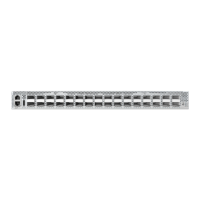C
HAPTER
20
| Unicast Routing
Configuring the Open Shortest Path First Protocol (Version 2)
– 526 –
◆ IP Address – Address of the interfaces assigned to a VLAN on the
Network Area (Add) page.
This parameter only applies to the Configure by Address page.
◆ Cost – Sets the cost of sending a protocol packet on an interface,
where higher values indicate slower ports. (Range: 1-65535;
Default: 1)
The interface cost indicates the overhead required to send packets
across a certain interface. This is advertised as the link cost in router
link state advertisements.
Routes are assigned a metric equal to the sum of all metrics for each
interface link in the route.
This router uses a default cost of 1 for all ports. Therefore, if you install
a 10 Gigabit module, you need to reset the cost for all of the 1 Gbps
ports to a value greater than 1 to reflect the actual interface bandwidth.
◆ Router Priority – Sets the interface priority for this router.
(Range: 0-255; Default: 1)
This priority determines the designated router (DR) and backup
designated router (BDR) for each OSPF area. The DR forms an active
adjacency to all other routers in the area to exchange routing topology
information. If for any reason the DR fails, the BDR takes over this role.
Set the priority to zero to prevent a router from being elected as a DR
or BDR. If set to any value other than zero, the router with the highest
priority becomes the DR and the router with the next highest priority
becomes the BDR. If two or more routers are set to the same highest
priority, the router with the higher ID will be elected.
If a DR already exists for an area when this interface comes up, the
new router will accept the current DR regardless of its own priority. The
DR will not change until the next time the election process is initiated.
Configure router priority for multi-access networks only and not for
point-to-point networks.
◆ Hello Interval – Sets the interval between sending hello packets on an
interface. This interval must be set to the same value for all routers on
the network. (Range: 1-65535 seconds; Default: 10)
Hello packets are used to inform other routers that the sending router
is still active. Setting the hello interval to a smaller value can reduce
the delay in detecting topological changes, but will increase routing
traffic.
◆ Dead Interval – Sets the interval at which hello packets are not seen
before neighbors declare the router down. This interval must be set to
the same value for all routers on the network. (Range: 1-65535
seconds; Default: 40, or 4 times the Hello Interval)
The dead-interval is advertised in the router's hello packets. It must be
a multiple of hello-interval and be the same for all routers on a specific
network.

